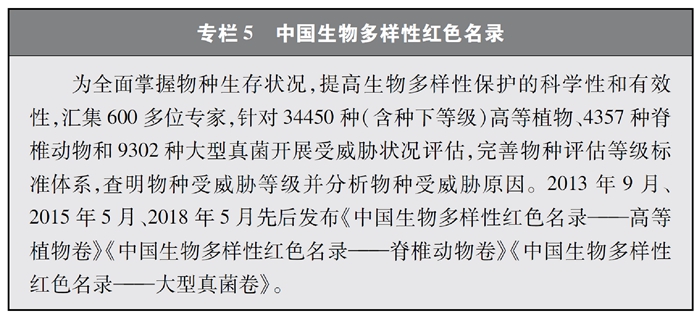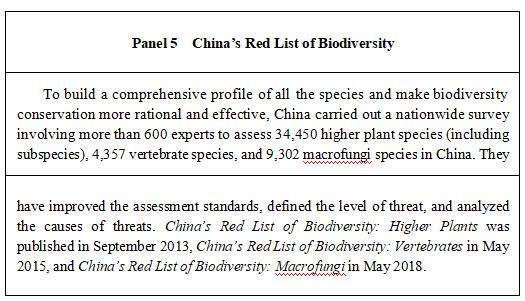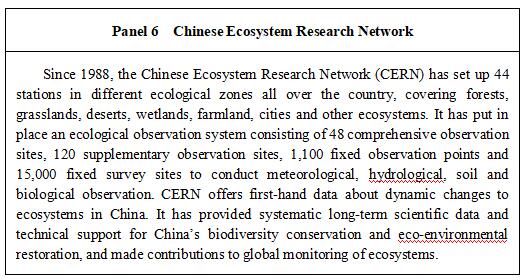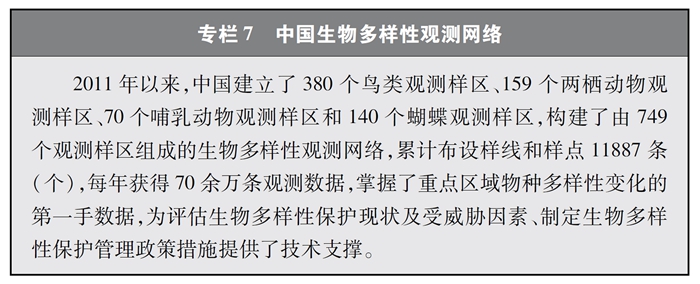《中国的生物多样性保护》白皮书(双语全文)
新华网 2021-10-09 09:17

三、提升生物多样性治理能力
III. Improving Biodiversity Governance
中国将生物多样性保护上升为国家战略,把生物多样性保护纳入各地区、各领域中长期规划,完善政策法规体系,加强技术保障和人才队伍建设,加大执法监督力度,引导公众自觉参与生物多样性保护,不断提升生物多样性治理能力。
Biodiversity conservation has been elevated to a national strategy in China, and incorporated into mid- and long-term plans of all regions and fields. There has been a drive to improve the legal and policy framework, strengthen technical support and the training of high-caliber personnel, expand oversight on law enforcement, and encourage public participation in conserving biodiversity, thus improving biodiversity governance.
(一)完善政策法规
1. Improving Relevant Policies, Laws and Regulations
中国不断建立健全生物多样性保护政策法规体系,制定相应的中长期规划和行动计划,为生物多样性保护和管理提供制度保障。
China is making constant efforts to establish and improve policies, laws and regulations on biodiversity conservation, and has drafted mid- and long-term programs and action plans to provide institutional guarantees for biodiversity conservation and management.
强化组织领导。成立由分管生态环境保护的国务院副总理任主任、23个国务院部门为成员的中国生物多样性保护国家委员会,统筹推进生物多样性保护工作。《中华人民共和国国民经济和社会发展第十四个五年规划和2035年远景目标纲要》明确将实施生物多样性保护重大工程、构筑生物多样性保护网络作为提升生态系统质量和稳定性的重要工作内容。发布并实施《中国生物多样性保护战略与行动计划》(2011-2030年),从建立健全生物多样性保护与可持续利用的政策与法律体系等10个优先领域,以及完善跨部门协调机制等30个行动方面对加强生物多样性保护进行有力指导。北京、江苏、云南等22个省、自治区、直辖市制定了省级生物多样性保护战略与行动计划。建立生态文明建设考核目标体系,将生物多样性保护相关指标纳入地方考核,压实生物多样性保护责任。
Strengthening organization and leadership. The China National Committee for Biodiversity Conservation (CNCBC) has been established to coordinate conservation actions. It is composed of 23 departments under the State Council, and headed by a Vice Premier who is in charge of environmental protection. To strengthen the quality and stability of our ecosystems, the Outline of the 14th Five-Year Plan (2021-2025) for National Economic and Social Development and the Long-Range Objectives Through the Year 2035 make provisions for implementing major biodiversity conservation projects and building a biodiversity conservation network.
The China National Biodiversity Conservation Strategy and Action Plan (2011-2030) has been issued and implemented, offering substantial guidance in 10 priority areas, including the policy and legal framework for biodiversity conservation and sustainable utilization of bio-resources, and 30 actions, including inter-departmental coordination mechanisms. Beijing, Jiangsu, Yunnan and 19 other provincial-level administrative units have formed local strategies and action plans accordingly.
China has put in place a system for evaluating performance in advancing ecological progress, based on which indicators of biodiversity conservation have been included in performance evaluation for local governments, urging them to fulfill their responsibilities for biodiversity conservation.
加强生物多样性法制建设。近10年来,颁布和修订森林法、草原法、渔业法、野生动物保护法、环境保护法、海洋环境保护法、种子法、长江保护法和生物安全法等20多部生物多样性相关的法律法规,覆盖野生动植物和重要生态系统保护、生物安全、生物遗传资源获取与惠益分享等领域,为生物多样性保护与可持续利用提供了坚实的法律保障。修订调整国家重点保护野生动植物名录,为拯救珍稀濒危野生动植物,维护生物多样性奠定基础。2020年,第十三届全国人民代表大会常务委员会第十六次会议通过了《关于全面禁止非法野生动物交易、革除滥食野生动物陋习、切实保障人民群众生命健康安全的决定》。各省(自治区、直辖市)结合当地实际颁布了相关法律法规,云南省制定了全国第一部生物多样性保护的地方性法规《云南省生物多样性保护条例》。
Strengthening the legal system for biodiversity conservation. Over the past decade, China has promulgated and revised more than 20 laws and regulations pertinent to biodiversity conservation, including laws on forestry, grassland, fishery, seed, biosecurity as well as laws on the protection of wild animals, the environment, marine environment, and the Yangtze River, covering the protection of wildlife and important ecosystems, biosecurity, access to and benefit-sharing of biogenetic resources, thus providing solid legal safeguards for biodiversity conservation and sustainable utilization of bio-resources.
China has also revised the list of key wild animals and plants under state protection, laying a foundation for rescuing rare and endangered wildlife and maintaining biodiversity. In 2020, the Standing Committee of the 13th National People’s Congress adopted at its 16th session the Decision to Comprehensively Prohibit the Illegal Trade of Wild Animals, Eliminate the Bad Habits of Wild Animal Consumption, and Protect the Health and Safety of the People.
Different provinces and equivalent administrative units have issued relevant regulations based on local conditions. Yunnan Province, for example, formulated its own biodiversity conservation regulation, the first local one in the country.
(二)强化能力保障
2. Extending Guarantees
组织开展全国生物多样性调查,建立完善生物多样性监测观测网络,不断加大资金投入和科技研发力度,生物多样性保护和治理能力全面提升。
China has organized nationwide biodiversity surveys, and put in place sound biodiversity monitoring and observation networks. It has increased financial input and effort in technology research and development to improve the capacity for biodiversity conservation and governance.
开展全国生物多样性调查与评估。大力推进生物多样性保护重大工程实施,结合自然资源调查、生态系统监测评估等工作,不断完善生物多样性调查与评估能力,首次将生物多样性指标纳入生态质量综合评价指标体系,引导地方加强生态文明建设与生物多样性保护。开展自然资源调查,包括森林、草原、水、湿地、荒漠、海洋等,建立自然资源调查评价监测制度。构建了涵盖2376个县级行政单元、样线总长超过3.4万公里的物种分布数据库,建立物种资源调查及收集信息平台,准确反映野生动植物空间分布状况。完成长江经济带、京津冀等国家战略区域180多个县级行政区生物多样性调查与评估。组织开展近海渔业资源调查,初步掌握近海渔业资源状况。陆续发布《中国植物红皮书》《中国濒危动物红皮书》《中国物种红色名录》《中国生物多样性红色名录》,基本掌握生物多样性总体情况,为加强生物多样性保护奠定了科学基础。
Conducting nationwide biodiversity surveys and assessment. To improve its biodiversity survey and assessment capacity, China has carried out major biodiversity conservation projects, in addition to surveys of natural resources and the monitoring and assessment of ecosystems. It has included biodiversity indicators in the system of comprehensive assessment indexes for ecological quality for the first time to guide local governments in protecting the eco-environment and biodiversity. A system for surveying, assessing and monitoring natural resources has been developed, and surveys on forests, grasslands, waters, wetlands, deserts, oceans and other natural resources have been carried out.
China has built a species distribution database, covering 2,376 county-level administrative units and totaling over 34,000 km in line transect. An information platform has been set up to survey and collect various species, accurately mapping the spatial distribution of wildlife.
China has completed biodiversity surveys and assessment in more than 180 county-level administrative units in the Yangtze River Economic Belt, Beijing-Tianjin-Hebei Region and some other national strategic areas. Offshore resources studies have been carried out to build an initial profile of fishery resources.
China has released the China Red Data Book of Plants, China Red Data Book of Endangered Animals, China Species Red List, and China’s Red List of Biodiversity to establish the overall situation of biodiversity and lay a scientific basis for better biodiversity conservation.


完善监测观测网络。中国建立起各类生态系统、物种的监测观测网络,在生物多样性理论研究、技术示范与推广以及物种与生境保护方面发挥了重要作用,为科研、教育、科普、生产等各领域提供了多样化的信息服务与决策支持。其中,中国生态系统研究网络(CERN)、国家陆地生态系统定位观测研究网络(CTERN)涵盖所有生态系统和要素,中国生物多样性监测与研究网络(Sino BON)覆盖动物、植物、微生物等多种生物类群,中国生物多样性观测网络(China BON)构建了覆盖全国的指示物种类群观测样区。
Improving monitoring and observation networks. China has put in place monitoring and observation networks for various ecosystems and species. These networks have played an important role in supporting biodiversity research, demonstrating and promoting relevant technology, and protecting species and their habitats, thereby providing diverse information services and decision-making support for scientific research and education, popularizing science and exploiting resources. Among them, the Chinese Ecosystem Research Network (CERN) and the Chinese Terrestrial Ecosystem Research Network (CTERN) cover all ecosystems and elements; the China Biodiversity Monitoring and Research Network (Sino BON) covers a variety of biological groups such as animals, plants and microorganisms; the China Biodiversity Observation Network (China BON) has designated plots for the observation of indicator species all over the country.




加强资金保障。近年来,中国持续加大投入生物多样性保护领域的资金,为加强生物多样性保护提供重要保障。2017-2018年,连续两年安排超过2600亿资金投入生物多样性相关工作,是2008年投入的6倍。同时,利用财税激励措施,积极调动民间资本投入生物多样性保护。2020年,设立国家绿色发展基金,首期募资规模885亿元。
Increasing financial support. China has expanded funding for biodiversity conservation in recent years. More than RMB260 billion was earmarked in biodiversity-related causes in each of 2017 and 2018, six times the figure of 2008. Meanwhile, China has used fiscal and tax incentives to mobilize private capital to invest in biodiversity conservation. In 2020, a national green development fund was set up, raising RMB88.5 billion as a start.
强化科技与人才支撑。设立生物多样性保护领域研究专项,构建数据库和信息平台,完善生物多样性调查、观测和评估等相关技术和标准体系,为生物多样性保护提供有力科技支撑。通过“生物多样性保护专项”“典型脆弱生态修复与保护研究”“物种资源保护专项”“珍稀濒危野生动物保护专项”等一批基础科研项目,加强濒危野生动植物恢复与保护、种质资源和遗传资源保存、生物资源可持续利用和产业化等技术研发,逐步构建生物多样性保护和生物资源可持续利用技术体系。发挥高校和科研院所优势,推进科教融合,加强生物多样性人才培养。
Strengthening technical and talent support. China has set up special projects on biodiversity research, developed database and information platforms, and improved technologies and standards for survey, observation and assessment to provide strong technical support for biodiversity conservation. Through some basic scientific research projects on biodiversity conservation, restoration and protection of typical vulnerable ecosystems, conservation of species, and protection of rare and endangered wildlife, China has stepped up technology research and development in the restoration and protection of endangered wildlife, conservation of germplasm and genetic resources, and sustainable and profitable use of biological resources. This way, it has gradually built a technical system for biodiversity conservation and sustainable use of biological resources. China has taken full advantage of the strengths of universities and research institutes, and integrated science and education to reinforce the training of professionals on biodiversity.
(三)加强执法监督
3. Strengthening Law Enforcement and Supervision
开展中央生态环境保护督察,解决突出生态环境问题,改善生态环境质量,推动经济社会高质量发展。组织打击野生动植物非法贸易等专项执法行动,持续加大涉及生物多样性违法犯罪问题的打击整治力度,坚决制止和惩处破坏生态系统、物种和生物资源的行为。
China has conducted central environmental protection inspections to solve outstanding problems, improve eco-environmental quality, and promote high-quality economic and social development. It has organized special actions against illegal wildlife trade, and increased its effort to combat illegal and criminal activities concerning biodiversity. It has taken tough steps to stop and punish all activities that do damage to ecosystems, species and biological resources.
加大中央生态环境保护督察力度。2015年起,建立中央生态环境保护督察制度,逐步覆盖31个省、自治区、直辖市和国务院有关部门、部分中央企业。坚持问题导向,重点围绕生物多样性保护、应对气候变化、长江十年禁渔、海洋生态环境保护等重大任务开展督察,推动解决一批生态环境领域的突出问题。中央生态环境保护督察制度有力推动各级政府和部门承担起保护生态环境的责任,为生物多样性保护提供强大的制度保障。
Strengthening central inspection on eco-environmental protection. The system of central inspection on eco-environmental protection was established in 2015. Since then, it has been developed to cover 31 provincial-level administrative units, relevant departments under the State Council and some state-owned enterprises directly under the central government. To solve prominent environmental problems, China has carried out inspections focusing on major issues such as biodiversity conservation, climate change, the 10-year ban on fishing in the Yangtze River, and marine environmental protection. The system serves to push governments at all levels and relevant departments to take responsibility for protecting the eco-environment, providing strong institutional guarantees for conserving biodiversity.
开展生物多样性保护执法检查。开展跨部门、跨区域和跨国联合执法行动,严厉打击珍稀濒危野生动植物走私,对涉及野生动植物交易等违法活动采取零容忍态度。健全野生动物保护执法监管长效机制,开展“绿盾”自然保护地强化监督、“碧海”海洋生态环境保护、“中国渔政亮剑”、“昆仑行动”等系列执法行动,对影响野生动植物及其栖息地保护的行为进行严肃查处。建立长江禁捕退捕的跨区域跨部门联合执法联动协作机制,加大非法捕捞专项整治力度,对相关违法犯罪行为形成高压态势。
Carrying law enforcement inspections on biodiversity conservation. Adopting a zero-tolerance policy toward illegal activities involving wildlife trade, China has carried out trans-department, cross-region and cross-border joint actions to crack down on the trafficking of rare and endangered wildlife. It has improved the long-term mechanism for monitoring law enforcement concerning wild animal protection. Special law enforcement campaigns have been launched to combat illegal activities threatening wildlife and their habitats, including the Green Shield inspections of nature reserves, the Blue Sea initiative for marine environmental protection, the Sword campaigns targeting fisheries, and the Kunlun actions against crimes and violations in the fields of food, drugs and the environment. In a tough stand against illegal activities, China has established collaboration mechanisms for cross-region and trans-department joint actions on enforcing the Yangtze River fishing ban and withdrawal of fishermen concerned, and has conducted special campaigns against illegal fishing.
(四)倡导全民行动
4. Encouraging Public Engagement
中国不断加强生物多样性保护宣传教育,政府加强引导、企业积极行动、公众广泛参与的行动体系基本形成,公众参与生物多样性保护的方式更加多元化,参与度全面提高。持续开展生物多样性保护宣传教育和科普活动,在国际生物多样性日、世界野生动植物日、世界湿地日、六五环境日、水生野生动物保护科普宣传月等重要时间节点举办系列活动,调动全社会广泛参与,进一步增强公众保护意识。创新宣传模式,拓宽参与渠道,完善激励政策,邀请公众在生物多样性政策制定、信息公开与公益诉讼中积极参与、建言献策,营造生物多样性保护的良好氛围。发布《“美丽中国,我是行动者”提升公民生态文明意识行动计划(2021-2025年)》《关于推动生态环境志愿服务发展的指导意见》,为各类社会主体和公众参与生物多样性保护工作提供指南和规范。成立长江江豚、海龟、中华白海豚等重点物种保护联盟,为各方力量搭建沟通协作平台。加入《生物多样性公约》秘书处发起的“企业与生物多样性全球伙伴关系”(GPBB)倡议,鼓励企业参与生物多样性领域工作,积极引导企业参与打击野生动植物非法贸易。
China continues to strengthen publicity and education on biodiversity conservation. An action system involving stronger government guidance, corporate action, and extensive public participation is taking shape. Public participation in biodiversity conservation has grown and become more diversified.
Public awareness activities and dissemination of knowledge on biodiversity are being carried out. On important occasions such as the International Day for Biological Diversity, World Wildlife Day, World Wetlands Day, World Environment Day, and Aquatic Wildlife Conservation Public Awareness Month, events will be held to encourage broad social participation and raise public awareness of eco-environmental conservation.
China has explored new publicity models, broadened participation channels, improved incentives, and invited public participation in policy making, information disclosure and public-interest litigation related to biodiversity, creating a positive environment for biodiversity conservation. Beautiful China, I’m a Contributor – Action Plan to Raise Public Awareness of Ecological Conservation (2021-2025), and Guidelines on Advancing Volunteer Service in Eco-environmental Protection have been released to provide guidelines and norms for entities and individuals to participate in biodiversity conservation.
China has formed alliances for protecting key species including the Yangtze finless porpoise, the turtle and the Chinese white dolphin, which serve as platforms of communication and cooperation for all stakeholders.
In 2015, China joined the Global Partnership for Business and Biodiversity (GPBB), initiated by the Secretariat of the Convention on Biological Diversity. Enterprises are encouraged to take part in biodiversity-related initiatives and actions against illegal wildlife trade.

















 英语点津微信
英语点津微信 双语小程序
双语小程序